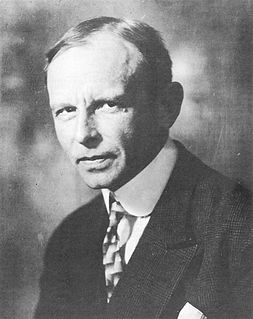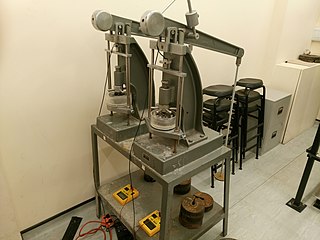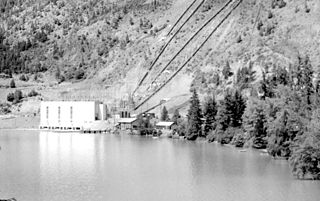Related Research Articles

Geotechnical engineering, also known as geotechnics, is the branch of civil engineering concerned with the engineering behavior of earth materials. It uses the principles and methods of soil mechanics and rock mechanics for the solution of engineering problems and the design of engineering works. It also relies on knowledge of geology, hydrology, geophysics, and other related sciences.
ATC code A11Vitamins is a therapeutic subgroup of the Anatomical Therapeutic Chemical Classification System, a system of alphanumeric codes developed by the World Health Organization (WHO) for the classification of drugs and other medical products. Subgroup A11 is part of the anatomical group A Alimentary tract and metabolism.
Vehicle size classes are series of ratings assigned to different segments of automotive vehicles for the purposes of vehicle emissions control and fuel economy calculation. Various methods are used to classify vehicles; in North America, passenger vehicles are classified by total interior capacity while trucks are classified by gross vehicle weight rating (GVWR). Vehicle segments in the European Union use linear measurements to describe size. Asian vehicle classifications are a combination of dimensions and engine displacement.
USDA soil taxonomy (ST) developed by United States Department of Agriculture and the National Cooperative Soil Survey provides an elaborate classification of soil types according to several parameters and in several levels: Order, Suborder, Great Group, Subgroup, Family, and Series. The classification was originally developed by Guy Donald Smith, former director of the U.S. Department of Agriculture's soil survey investigations.

Soil classification deals with the systematic categorization of soils based on distinguishing characteristics as well as criteria that dictate choices in use.

Soil mechanics is a branch of soil physics and applied mechanics that describes the behavior of soils. It differs from fluid mechanics and solid mechanics in the sense that soils consist of a heterogeneous mixture of fluids and particles but soil may also contain organic solids and other matter. Along with rock mechanics, soil mechanics provides the theoretical basis for analysis in geotechnical engineering, a subdiscipline of civil engineering, and engineering geology, a subdiscipline of geology. Soil mechanics is used to analyze the deformations of and flow of fluids within natural and man-made structures that are supported on or made of soil, or structures that are buried in soils. Example applications are building and bridge foundations, retaining walls, dams, and buried pipeline systems. Principles of soil mechanics are also used in related disciplines such as geophysical engineering, coastal engineering, agricultural engineering, hydrology and soil physics.
Rock mass classification systems are used for various engineering design and stability analysis. These are based on empirical relations between rock mass parameters and engineering applications, such as tunnels, slopes, foundations, and excavatability. The first rock mass classification system in geotechnical engineering was proposed in 1946 for tunnels with steel set support.

Karl von Terzaghi was an Austrian mechanical engineer, geotechnical engineer, and geologist known as the "father of soil mechanics and geotechnical engineering".
The Atterberg limits are a basic measure of the critical water contents of a fine-grained soil: its shrinkage limit, plastic limit, and liquid limit.
The Unified Soil Classification System (USCS) is a soil classification system used in engineering and geology to describe the texture and grain size of a soil. The classification system can be applied to most unconsolidated materials, and is represented by a two-letter symbol. Each letter is described below :

Soil consolidation refers to the mechanical process by which soil changes volume gradually in response to a change in pressure. This happens because soil is a two-phase material, comprising soil grains and pore fluid, usually groundwater. When soil saturated with water is subjected to an increase in pressure, the high volumetric stiffness of water compared to the soil matrix means that the water initially absorbs all the change in pressure without changing volume, creating excess pore water pressure. As water diffuses away from regions of high pressure due to seepage, the soil matrix gradually takes up the pressure change and shrinks in volume. The theoretical framework of consolidation is therefore closely related to the diffusion equation, the concept of effective stress, and hydraulic conductivity.

The Bridge River Power Project is a hydroelectric power development in the Canadian province of British Columbia, located in the Lillooet Country between Whistler and Lillooet. It harnesses the power of the Bridge River, a tributary of the Fraser, by diverting it through a mountainside to the separate drainage basin of Seton Lake, utilizing a system of three dams, four powerhouses and a canal.
The Canadian System of Soil Classification is more closely related to the American system than any other, but they differ in several ways. The Canadian system is designed to cover only Canadian soils. The Canadian system dispenses with the sub-order hierarchical level. Solonetzic and Gleysolic soils are differentiated at the order level.

Albert Mauritz Atterberg was a Swedish chemist and agricultural scientist who created the Atterberg limits, which are commonly referred to by geotechnical engineers and engineering geologists today. In Sweden he is equally known for creating the Atterberg grainsize scale, which remains the one in use.
Dr. Ralph Brazelton Peck was an eminent civil engineer specializing in soil mechanics. He was awarded the National Medal of Science in 1976 "for his development of the science and art of subsurface engineering, combining the contributions of the sciences of geology and soil mechanics with the practical art of foundation design"?

Arthur Casagrande was an Austrian-born American civil engineer who made important contributions to the fields of engineering geology and geotechnical engineering during its infancy. Renowned for his ingenious designs of soil testing apparatus and fundamental research on seepage and soil liquefaction, he is also credited for developing the soil mechanics teaching programme at Harvard University during the early 1930s that has since been modelled in many universities around the world.
Donald M. Burmister was a professor of civil engineering and a pioneer in the field of soil mechanics and geotechnical engineering.
Preconsolidation pressure is the maximum effective vertical overburden stress that a particular soil sample has sustained in the past. This quantity is important in geotechnical engineering, particularly for finding the expected settlement of foundations and embankments. Alternative names for the preconsolidation pressure are preconsolidation stress, pre-compression stress, pre-compaction stress, and preload stress. A soil is called overconsolidated if the current effective stress acting on the soil is less than the historical maximum.

An oedometer test is a kind of geotechnical investigation performed in geotechnical engineering that measures a soil's consolidation properties. Oedometer tests are performed by applying different loads to a soil sample and measuring the deformation response. The results from these tests are used to predict how a soil in the field will deform in response to a change in effective stress.

J. Carlos Santamarina is a professor of Energy Resources and Petroleum Engineering at King Abdullah University of Science and Technology (KAUST), Jeddah, Kingdom of Saudi Arabia and the Associate Director of the Ali I. Al-Naimi Petroleum Engineering Research Center.
References
- ↑ Hogentogler, C.A.; Terzaghi, K. (May 1929). "Interrelationship of load, road and subgrade". Public Roads: 37–64.